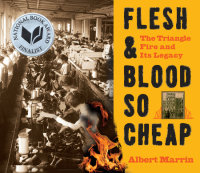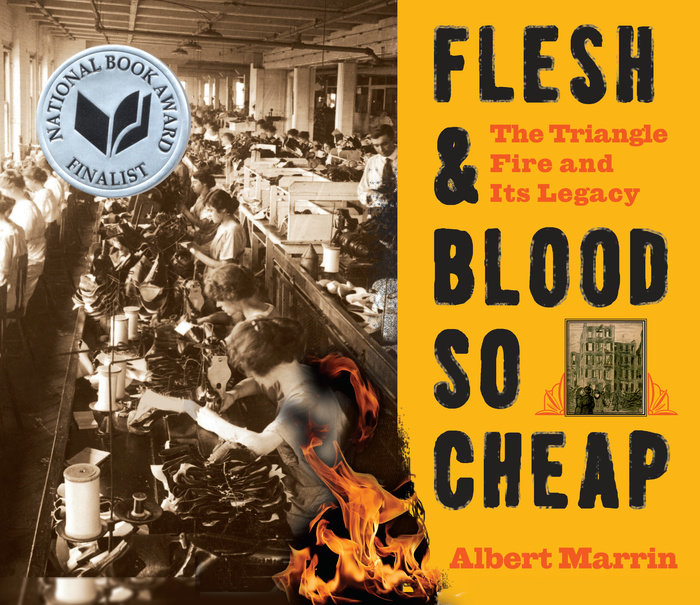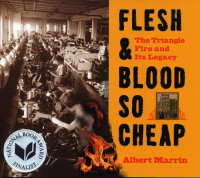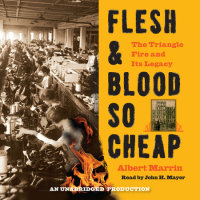Flesh and Blood So Cheap: The Triangle Fire and Its Legacy
On March 25, 1911, the Triangle Shirtwaist Factory in New York City burst into flames. The factory was crowded. The doors were locked to ensure workers stay inside. One hundred forty-six people—mostly women—perished; it was one of the most lethal workplace fires in American history until September 11, 2001.
But the story of the fire is not the story of one accidental moment in time. It is a story of immigration and hard work to make it in a new country, as Italians and Jews and others traveled to America to find a better life. It is the story of poor working conditions and greedy bosses, as garment workers discovered the endless sacrifices required to make ends meet. It is the story of unimaginable, but avoidable, disaster. And it the story of the unquenchable pride and activism of fearless immigrants and women who stood up to business, got America on their side, and finally changed working conditions for our entire nation, initiating radical new laws we take for granted today.
With Flesh and Blood So Cheap, Albert Marrin has crafted a gripping, nuanced, and poignant account of one of America's defining tragedies.
An Excerpt fromFlesh and Blood So Cheap: The Triangle Fire and Its Legacy
I
HUDDLED MASSES
Give me your tired, your poor, Your huddled masses yearning to breathe free, The wretched refuse of your teeming shore, Send these, the homeless, tempest-tost to me, I lift my lamp beside the golden door!
--Emma Lazarus, "The New Colossus" (1883), inscription on the pedestal of the Statue of Liberty
Immigration Old and New
In the spring of 1903, Sadie Frowne, age thirteen, and her mother sailed into New York Harbor aboard a steamship crowded with immigrants from Europe. Finally, their voyage had ended. As the passengers gathered on deck, Sadie recalled, they marveled at a giant green figure that seemed to rise out of the water. She never forgot "the big woman with the spikes on her head and the lamp that is lighted at night in her hand." Thus, the Statue of Liberty welcomed the newcomers to the United States and, they prayed, to a better life.
Although America has always been a land of hope, immigrants have come from different places, at different times, for different reasons. This has led historians to divide immigration into two phases: old and new. The old immigration began in colonial times, more than a century before the United States existed as an independent nation. Over the generations, immigrants came from western and northern Europe: England, Scotland, Ireland, Holland, Germany, Norway, Sweden, Denmark. Except for Irish Catholics, most "old" immigrants were of the Protestant faith and could read and write their native language. Despite hardships, these people soon found their place in America.
The shift from the old to the new immigration began in the 1880s. While immigrants continued to arrive from the familiar places, a flood of humanity also came from southern and eastern Europe: Italy, Greece, Hungary, Romania, Poland, Russia. By 1910, people from these countries made up seven out of ten immigrants entering the United States, chiefly through New York City. Of these, the vast majority were Italians (mainly Catholic) and Jews from Russia. Because nearly all the victims of the Triangle Fire were from these two groups, we must look at them closely.
The Land Time Forgot
Educated Americans had always admired Italy as a land of beauty and culture. Each year, thousands of tourists visited its ancient cities--Rome, Florence, Milan, Venice--to see their splendid churches, museums, and art galleries. Music lovers filled the opera houses and concert halls. Yet few Americans realized that Italy was really two countries.
Northern Italy, the area tourists favored, was more advanced economically than the southern areas. The nation's industries, banks, and major businesses were based in the north. Since the government was in Rome, the capital, Northerners made the laws, controlled the courts, and commanded the police. For them, the south was little more than an uncivilized colony, an extension of Africa.
If you look at a map, you will see that southern Italy forms the heel and toe of the Italian "boot." The boot, in turn, "kicks" Sicily, an Italian island in the Mediterranean Sea. Known as "the land time forgot," the south was a region of small farms and villages that lagged behind the industrial north in all things but la miseria--misery.
Misery ruled southern Italy. The majority of its people were among the poorest in Europe. Peasants, or farmers, did not own the land, but worked tiny parcels rented from wealthy landlords, chiefly nobles and northern businessmen. Landlords demanded high rents, so peasants could not afford to buy fertilizer or machinery. Instead, they tilled the soil with hand plows and hoes that were old when their grandparents were children. Peasant families were large and worked together, including children, who were given small chores nearly from the moment they could walk. Youngsters attended school briefly if at all, for they had to help in the fields. Large families lived in tiny, cramped cottages, merely shacks with earthen floors and shared with a prized goat or rooster.
Northerners had little respect for southerners, nicknamed "Black Italians" in a racist epithet meant to show their "inferiority"; they called Sicilians "Africans." The government in Rome cheated the south in countless ways. It built no modern roads or bridges there. Instead, it acted like a gigantic straw, sucking out whatever money it could. Heavy taxes collected in the south were spent in the north. Worse, justice was a cruel farce. If wronged by a landlord, a peasant was out of luck. Courts and police served the landlord. This, in turn, made peasants cynical, convinced others acted only for selfish reasons. Proverbs expressed their outrage: "The gallows is for the poor man, the law courts for the fool," "The law works against people," "The fat pig pays no taxes." If one person killed another, the victim's family took justice into its own hands, vowing to "wash blood with blood."
Mother Nature herself seemed to turn against the land time forgot. Massive cutting down of forests for firewood and building materials harmed the environment. Without tree roots to hold the soil in place, rain washed away fertile soil, causing crop failures and hunger. Elsewhere, swamps formed. Mosquitos breed in swamps. If a certain species of mosquito bites a person, it may inject a microscopic organism that causes malaria. This disease has killed more people than all history's wars, famines, and natural disasters combined. By the 1880s, malaria had become epidemic in southern Italy.
Disasters burst from within the earth, too. In 1905, earthquakes shook the region, collapsing buildings and burying their inhabitants under the rubble. The next year, Mount Vesuvius erupted. Located just east of Naples, this volcano had a fearsome history. An eruption in the year AD 79 buried the cities of Pompeii and Herculaneum, killing all their inhabitants. The 1906 eruption sent "explosions of red-hot stones" a half mile into the air. "The end of the world has come!" people cried in panic. "The inhabitants of the villages in the vicinity of Mount Vesuvius are in a condition of terror," said the New York Times.



